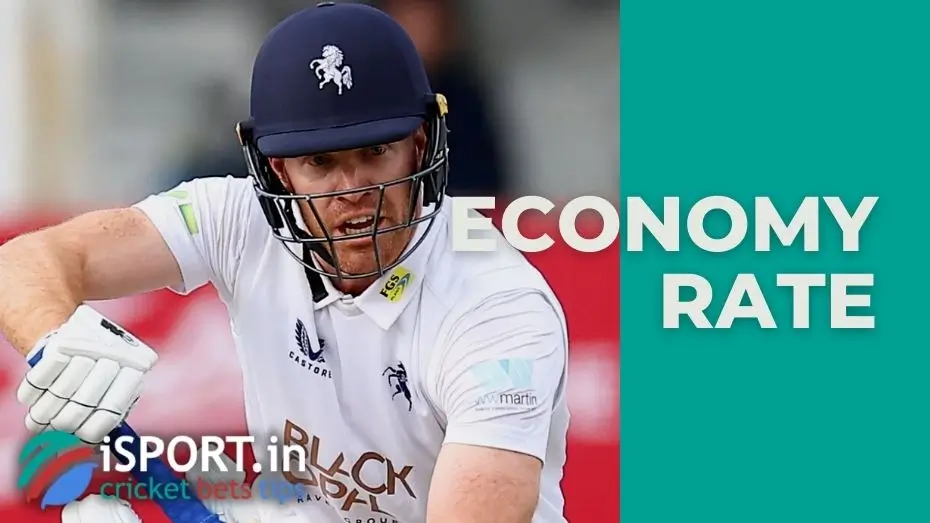Economy rate

Cricket fans get that the economy rate isn’t just some random number on a scorecard. It’s a real way to take charge – something that can set strategies and even influence how people see a bowler. The number indicates how many runs a bowler typically concedes per over, giving a straightforward view of how well they handle the flow of a game.
In this article, we’ll dive into how to calculate it right, chat about what the number means in Tests, ODIs, and T20s, and check out how today’s analysts are using it to find fresh insights on performance.
What Is Economy Rate and How It’s Calculated
To understand the economy rate meaning in cricket, you need a quick refresher on a few core terms. Cricket’s stats may look intimidating, but they follow simple logic – success isn’t just about scoring runs, but how efficiently players score or defend them.
So, when people talk about a bowler‘s economy rate, they’re just referring to how many runs they give up on average per over. The smaller this number is, the more control you’ve got. A bowler who keeps their economy rate low is usually viewed as dependable, chill and clever with their throws.
Here’s a short table to get you oriented:
| Term | Meaning | Note |
| Run | A point scored by the batsman | Can be 1, 2, 3, or more per hit |
| Over | A series of six legal deliveries (balls) | The bowler changes after each over |
| Bowler | The player delivering the ball | His goal is to dismiss the batsman or restrict runs |
| Batsman | The player hitting the ball | Scores runs by striking the ball |
| Economy Rate (ER) | Average number of runs conceded per over | Calculated by a simple formula |
How to Calculate the Economy Rate: Formula and Example
The economy rate is calculated using a simple formula.
Formula:
Economy Rate = Runs Conceded ÷ Overs Bowled
Here, Runs Conceded means the total number of runs the bowler allowed, and Overs Bowled is how many overs he delivered. Remember: one over equals six balls.
For example, if a bowler completed 7.4 overs, that doesn’t mean seven and four-tenths. It means 7 full overs and 4 out of 6 balls. To convert it into a decimal, you divide 4 by 6, getting 0.67. So, 7.4 overs = 7.67 overs in decimal form.
Let’s break it down with real numbers:
- The bowler completed 8.2 overs and conceded 46 runs.
- Convert 8.2 overs into decimal form: 8 + (2 ÷ 6) = 8.33 overs.
- Divide runs conceded by overs bowled: 46 ÷ 8.33 = 5.52.
- The result: the economy rate is 5.52, meaning the bowler gave away an average of 5.52 runs per over.
You always need to look at the context. A high economy rate doesn’t automatically mean poor bowling. If a player bowls during the death overs (the final, most aggressive phase), where batsmen usually go all-in, the numbers might rise, but the bowler’s role in controlling the match flow could still be crucial.
How to Analyse and Interpret the Economy Rate
The economy rate shows how well a bowler keeps batters in check, but to truly understand it, you’ve got to consider the format, the situation, and the opposition. Here’s how to read it like a pro:
- Compare with other bowlers. Don’t look at the number in isolation – compare it to others in the same match or tournament.
- Adjust for match format:
- In T20 cricket, around 7 runs per over is decent; 6 or below means elite.
- In ODIs, around 5 is solid; below 4.5 is top-tier.
- In Tests, 3 or less signals great control and patience.
- Analyze the opposition. Containing big hitters boosts the value of even an average economy rate.
- Watch conditions. Weather, humidity, pitch wear and wind all affect ball swing and pace.
- Compare with team or tournament averages. This gives the stat real context instead of chasing an arbitrary “perfect” number.
If you use it right, the economy rate is one of the coolest tools for strategy in cricket. Coaches use it to figure out bowling orders, analysts count on it for checking out player performance and captains use it to plan field setups and the pace of the game.
Top Bowlers with the Best Economy Rates
When talking about the best economy rate bowlers, a few names consistently make the headlines. Among current players, Rashid Khan and Jasprit Bumrah are often at the top. They’ve consistently kept their economy rates around six runs per over in international T20s for years. In longer formats, Josh Hazlewood and Trent Boult stand out as models of precision and control.
And when it comes to Test cricket, it’s all about endurance and discipline. Pat Cummins and Vernon Philander are prime examples. Their accuracy and sheer consistency slow the tempo and force batsmen into mistakes.
